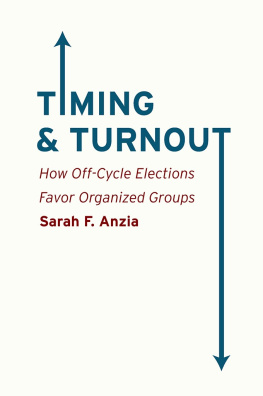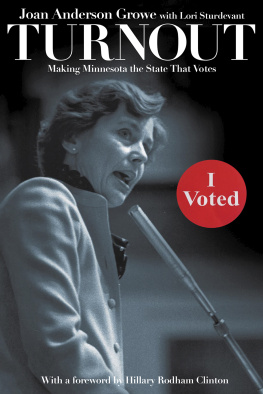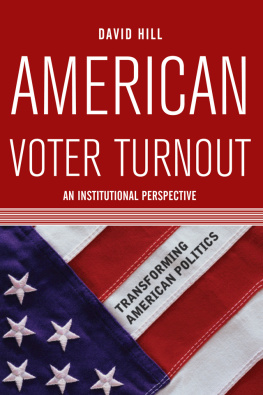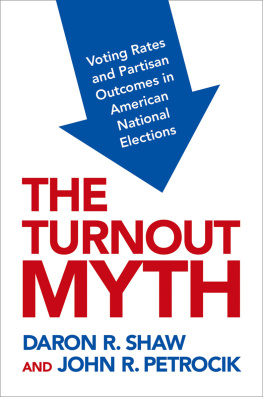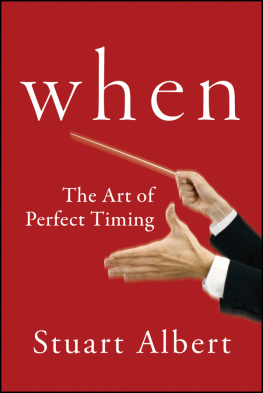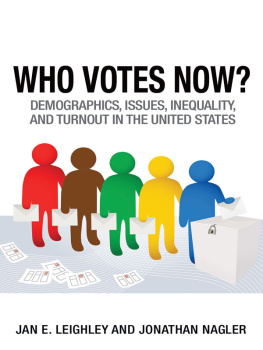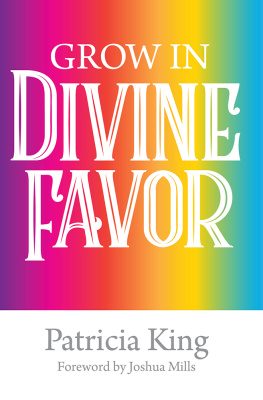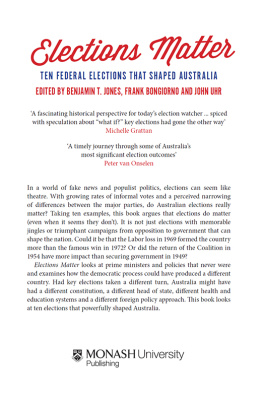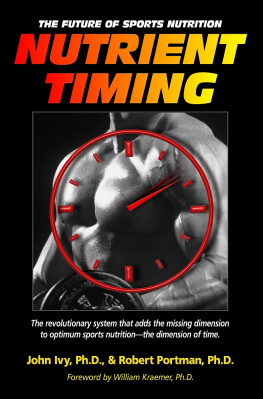SARAH F. ANZIA is assistant professor of public policy at the Goldman School of Public Policy at the University of California, Berkeley.
The University of Chicago Press, Chicago 60637
The University of Chicago Press, Ltd., London
2014 by The University of Chicago
All rights reserved. Published 2014.
Printed in the United States of America
23 22 21 20 19 18 17 16 15 14 1 2 3 4 5
ISBN-13: 978-0-226-08678-1 (cloth)
ISBN-13: 978-0-226-08681-1 (paper)
ISBN-13: 978-0-226-08695-8 (e-book)
DOI: 10.7208/chicago/9780226086958.001.0001
Library of Congress Cataloging-in-Publication Data
Anzia, Sarah F., author.
Timing and turnout : how off-cycle elections favor organized groups / Sarah F. Anzia.
pages cm
Includes bibliographical references and index.
ISBN 978-0-226-08678-1 (cloth : alk. paper)ISBN 978-0-226-08681-1 (pbk. : alk. paper)ISBN 978-0-226-08695-8 (e-book)
1. ElectionsUnited States. 2. Voter turnoutUnited States. I. Title.
JK1965.A69 2013
324.973dc23
2013022421

This paper meets the requirements of ANSI/NISO Z39.48-1992 (Permanence of Paper).
Acknowledgments
I have benefited from the guidance and support of many people as I have worked on this project. First and foremost, I am deeply indebted to my mentor and good friend Terry Moe. Not only did he encourage me to develop this project in the first place, but he also read multiple drafts of all the chapters, gave me feedback on the material I presented at workshops and conferences, and always had insightful comments and suggestions for how to improve the book. He has been a steady source of encouragement and inspiration, even when I encountered significant roadblocks. I have benefited in countless ways from his warmth and generosity. I am extremely grateful.
This project would not have become what it is without the support and feedback of a few key individuals. Special thanks to William Howell, who gave me incredibly helpful, thoughtful comments on the manuscript and who has been tremendously encouraging and supportive of the project. Thanks also to Chris Berry for getting me started down this path: it was through working as a research assistant for Chris at the University of Chicago and having several conversations with him about the timing of special district elections that I first started thinking about election timing as a research topic. I also owe a big thank you to Jonathan Rodden, who has read multiple drafts of these chapters and has given me many ideas on how to improve, extend, and frame my work. His support and guidance have been indispensable. I am also extremely fortunate to have had the help of Mike Tomz over the last few years. My conversations with Mike have helped me organize and clarify my ideas as well as improve my empirical work. Thanks, Mike, for all of the time and energy you have put into reading and critiquing my research. It has also been a pleasure to work with Morris Fiorina, whose big-picture comments on some of my earliest drafts of these chapters considerably shaped the trajectory of the project. I am indebted to Dave Brady for his unwavering support and enthusiasm and his reminders of the importance of studying big questions. Thanks to Jessica Trounstine for her detailed comments on the manuscript, for her many suggestions of different ways to test the theory, and for sharing data. And to Molly Jackman, thank you for your friendship and for all of the advice you have given me on this projectespecially in the spring of 2009 when we brainstormed for hours on end and you helped me straighten out my thinking.
This project also benefited from the advice, feedback, and support of a number of other people, including Josephine Andrews, Richard Bensel, Mike Binder, Carles Boix, Henry Brady, Isa Chaves, David Daniels, Kyle Dropp, John Ellwood, Sean Farhang, Jim Fearon, John Ferejohn, Tammy Frisby, Sean Gailmard, Justin Grimmer, Bobby Gulotty, Steve Haber, Scott Handler, Laurel Harbridge, Danielle Harlan, Saul Jackman, Simon Jackman, Karen Jusko, Vlad Kogan, Thad Kousser, Keith Krehbiel, Ruth Kricheli, Diqing Lou, Beatriz Magaloni, Neil Malhotra, Colin McCubbins, Victor Menaldo, Jeff Milyo, Clayton Nall, Maggie Peters, Ken Schultz, Gary Segura, Jas Sekhon, Paul Sniderman, Rachel Stein, Jonathan Wand, Amber Wichowsky, and Gerry Wright. Thanks to the Hayek Fund for Scholars donors and review committee for providing funding to purchase the 1986 ICMA dataset. I am also indebted to John Tryneski at the University of Chicago Press for his enthusiasm about the book, for his insights, and for selecting two fantastic reviewers who gave me incredibly helpful feedback on the manuscript. Many thanks also to Rodney Powell, who was very helpful with the technical aspects of the manuscript preparation, and to Tiffany Li, Kevin McNellis, and Anna Scodel for their research assistance.
Parts of Political Development 26, no. 1 (2012): 2449, Cambridge University Press. These parts of the chapter are reprinted with permission.
I am especially grateful for my family and friends who have been supportive of me as I have worked on this project, even when that work has come at the expense of my time with them. My parents, Joan and Dan, and my sisters, Carolyn and Maura, have been loving and understanding throughout. Thanks to Jill, David, Jimmy, Louis, Sandy, Lauren, Lijie, and Alexi for the many forms of support you have provided in the last few years. Special thanks to Bill McCready for encouraging me to apply to graduate school many years ago. My love and thanks to my daughter, Emma, for lighting up my life and giving me the proper perspective. And to Josh, my husband, words cannot express how grateful I am to have your love and support. Thank you for your endless patience, for your consistently good advice, and for being there for me in the good times and the tough times.
CHAPTER ONE
Timing and Turnout
The Basics
When it comes to voter turnout rates in industrialized democracies, the United States is at the bottom of the list. About 55 to 60% of eligible American voters participate in US presidential elections, compared to turnout rates of 91% in Belgium, 90% in Italy, 86% in Sweden, and 81% in Australia. Some of the gap between the United States and other democracies can be explained by unusual voter registration requirements in the United States and compulsory voting laws in countries like Belgium and Australia, but nonetheless, the differences are striking. In fact, the sole industrialized democracy whose turnout rates in national elections regularly fall below that of the United States is Switzerland, and with its average turnout rate of 54%, it is not far behind.
Moreover, turnout rates of 55 to 60% are by no means typical of elections in the United States; those figures describe American voter participation at its highest. Turnout in midterm congressional elections runs closer to 35%, and participation rates in national primary elections are lower still. Of course, American government is much more than just its national government. According to the preliminary counts of the 2012 Census of Governments, there are 89,055 individual governments in the United States, most of which are
 This paper meets the requirements of ANSI/NISO Z39.48-1992 (Permanence of Paper).
This paper meets the requirements of ANSI/NISO Z39.48-1992 (Permanence of Paper).
